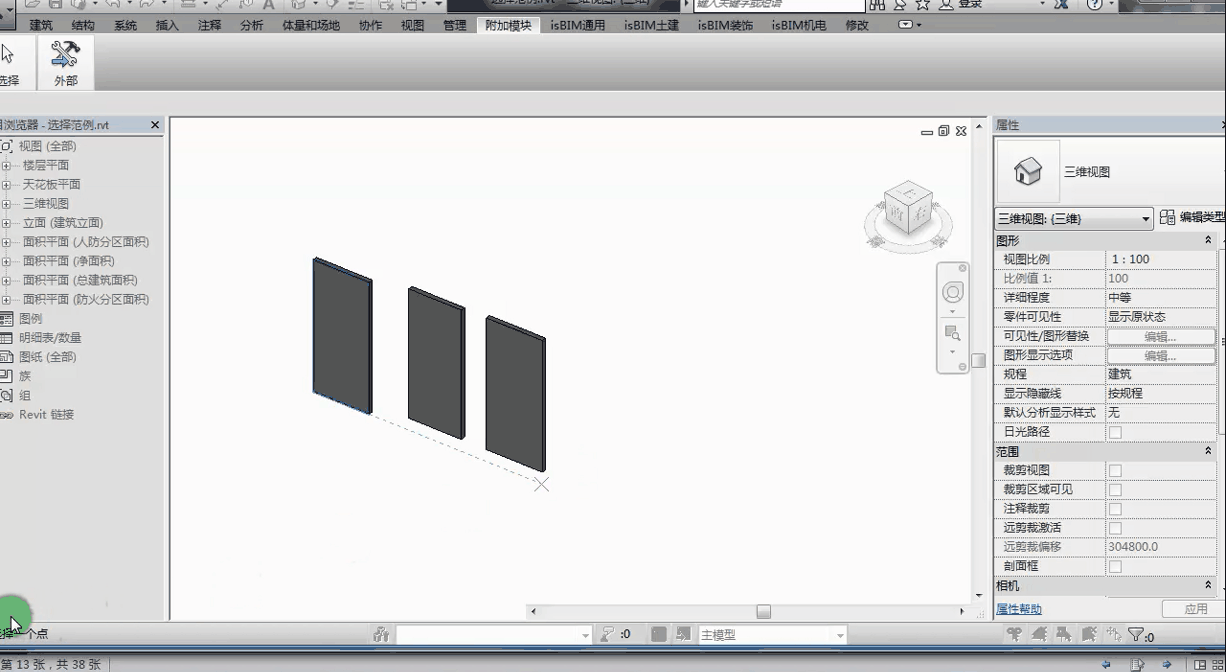[Revit二次開發] Selection互動API-建立柱子並計算體積
阿新 • • 發佈:2018-12-13
摘要:
本文主要是對Selection互動API的應用:
| 1.選擇一個點,在該點建立一個柱子; |
| 2.選擇剛建立的柱子,計算其體積; |
| 3.框選若干元素,得到選中的牆的數量。 |
專案完整程式碼:
using System; using System.Collections.Generic; using System.Linq; using System.Text; using System.Threading.Tasks; using Autodesk.Revit.DB; using Autodesk.Revit.DB.Structure;// StructuralType.NonStructural using Autodesk.Revit.UI; using Autodesk.Revit.UI.Selection; //Selection using Autodesk.Revit.Attributes; namespace Sele { [TransactionAttribute(TransactionMode.Manual)] [RegenerationAttribute(RegenerationOption.Manual)] public class Class1 : IExternalCommand { public Result Execute(ExternalCommandData commandData, ref string message, ElementSet elements) { UIDocument uidoc = commandData.Application.ActiveUIDocument; Document doc = uidoc.Document; //選擇一個點 Selection s1 = uidoc.Selection;//using Autodesk.Revit.UI.Selection; XYZ point = null; try { point = s1.PickPoint("請選擇一個點"); //將在Revit的左下角提示 } catch { return Result.Succeeded; } //由於需要修改點,所以需要建立一個事務Transaction Transaction t1 = new Transaction(doc,"t1"); t1.Start(); FamilySymbol familySymbol = doc.GetElement(new ElementId(338378)) as FamilySymbol;//建立一個柱子,其Id為338378 //判斷族型別 if (!familySymbol.IsActive) { familySymbol.Activate(); } Level level = null;//宣告標高 FamilyInstance fi = doc.Create.NewFamilyInstance(point, familySymbol, level, StructuralType.NonStructural);//using Autodesk.Revit.DB.Structure; Selection s2 = uidoc.Selection; Reference re = s2.PickObject(ObjectType.Edge, "請選擇一個物體"); Element ele = doc.GetElement(re); Options opt = new Options(); GeometryElement gelem = ele.get_Geometry(opt); double v = 0.0;//宣告體積 v = GetSolid(gelem).Sum(m => m.Volume) * 0.3048 * 0.3048 * 0.3048; TaskDialog.Show("Hint", "選中的物體體積為:" + v.ToString("f3")); //過濾元素"牆" IList<Element> pickedElements = s2.PickElementsByRectangle(new WallSelectionFilter(), "請框選目標物體"); double num = pickedElements.Count(); TaskDialog.Show("Hint", "已選中牆的數量為:" + num); return Result.Succeeded; } private List<Solid> GetSolid(GeometryElement gelem) { List<Solid> solids = new List<Solid>(); foreach(GeometryObject obj in gelem)//遍歷陣列gelem中每一個GeometryObject型別的物件 { if(obj is Solid)//元素是3d實體 { solids.Add(obj as Solid); } if(obj is GeometryElement)//GeometryElement:元素的幾何表示。 { solids.AddRange(GetSolid(obj as GeometryElement)); } if(obj is GeometryInstance) { GeometryInstance gins = obj as GeometryInstance; GeometryElement gelm = gins.GetInstanceGeometry(); solids.AddRange(GetSolid(gelem)); } } return solids; } } //自定義過濾器 public class WallSelectionFilter:ISelectionFilter { public bool AllowElement(Element elem) { return elem is Wall; } public bool AllowReference(Autodesk.Revit.DB.Reference reference,Autodesk.Revit.DB.XYZ position) { return true; } } }
效果:

參考文獻:
周婧禕《Autodesk Revit 2016二次開發入門教程》
